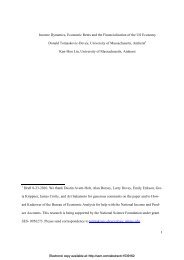Corporate governance and firm valuation
Corporate governance and firm valuation
Corporate governance and firm valuation
You also want an ePaper? Increase the reach of your titles
YUMPU automatically turns print PDFs into web optimized ePapers that Google loves.
428 L.D. Brown, M.L. Caylor / Journal of Accounting <strong>and</strong> Public Policy 25 (2006) 409–434<br />
is easier to alter internal than external measures, we expect Gov-7 to have more<br />
temporal variation than our modified version of the BCF entrenchment index.<br />
In untabulated results, we find that from 2003 to 2005 Gov-7 experienced a<br />
mean increase of 25.97% (significantly different from zero) while ENT had a<br />
mean decrease of 0.94% (insignificantly different from zero). 29 The 2003–<br />
2005 time period coincides with significant internal <strong>governance</strong> changes<br />
brought about by the Sarbanes–Oxley Act <strong>and</strong> the three major US stock<br />
exchanges so it is not surprising that a summary corporate <strong>governance</strong> measure<br />
incorporating both internal <strong>and</strong> external factors changes much more temporally<br />
than one confined to external <strong>governance</strong> measures. One desirable feature<br />
of a summary index is that it reflects changes in the overall <strong>governance</strong> environment<br />
such as those major changes occurring in the last few years. Our evidence<br />
that Gov-7 changes much more over time than does ENT suggests that ISS<br />
data have relatively more of this desirable feature than do IRRC data.<br />
8. Discussion<br />
We now discuss how the seven <strong>governance</strong> factors that constitute Gov-7 span<br />
the eight ISS <strong>governance</strong> categories, <strong>and</strong> which <strong>governance</strong> measures m<strong>and</strong>ated<br />
either by the Sarbanes–Oxley Act of 2002 (SOX) or the three major US stock<br />
exchanges are linked to <strong>firm</strong> <strong>valuation</strong>. None of the four <strong>governance</strong> factors categorized<br />
by ISS as audit-related are linked to <strong>firm</strong> value, including two instituted<br />
by SOX: (1) audit committee consists solely of independent outsiders; <strong>and</strong> (2)<br />
consulting fees paid to auditors are less than audit fees paid to auditors. Our first<br />
finding is similar to Klein (1998) who found audit committee independence to be<br />
unrelated to <strong>firm</strong> profitability. Our second finding is similar to Ashbaugh et al.<br />
(2003) <strong>and</strong> Larcker <strong>and</strong> Richardson (2004) who found the magnitude of nonaudit<br />
versus audit services to be unrelated to earnings management. 30<br />
Only three of the 17 <strong>governance</strong> factors categorized by ISS as board of<br />
directors are linked to <strong>firm</strong> <strong>valuation</strong>: (1) all directors attended at least 75%<br />
of board meetings or had a valid excuse for non-attendance; (2) board members<br />
are elected annually; (3) <strong>and</strong> board guidelines are in each proxy statement.<br />
The latter is not a requirement of SOX but it is a requirement of the NYSE. 31<br />
Neither of the first two <strong>governance</strong> factors is required by SOX or the three<br />
29 The 2005 data used for this purpose were ISS data as of February 1, 2005, precisely two years<br />
after the ISS data used in the rest of our study. Since we require <strong>firm</strong>s having relevant data for both<br />
years in this analysis, attrition reduced our sample size to 1738.<br />
30 Similarly, Kinney et al. (2004) found no relation between earnings restatements <strong>and</strong> fees paid<br />
for financial information systems design <strong>and</strong> implementation or internal audit services, <strong>and</strong><br />
Agrawal <strong>and</strong> Chadha (2005) found no relation between audit committee independence or the extent<br />
auditors provide non-audit services with the probability a <strong>firm</strong> restates its earnings.<br />
31 http://www.nyse.com/Frameset.html?displayPage=/lcm/1078416930906.html?archive=no.







